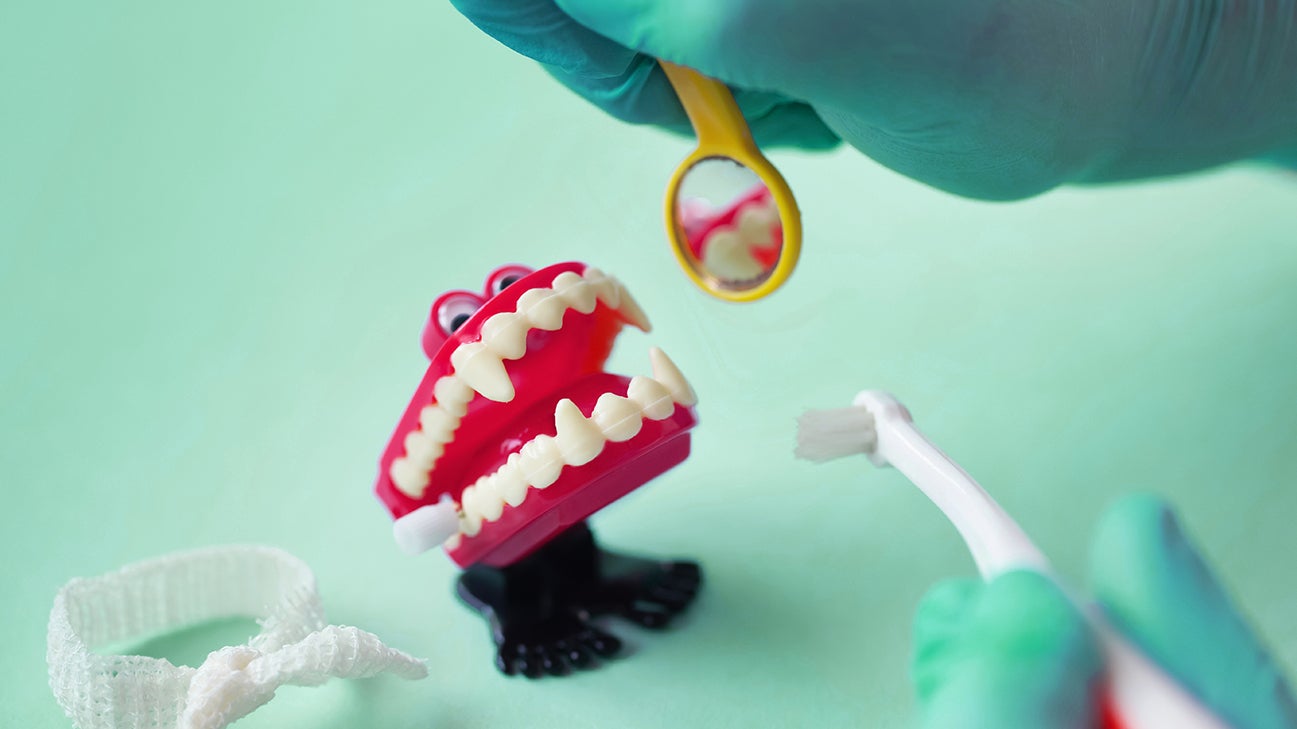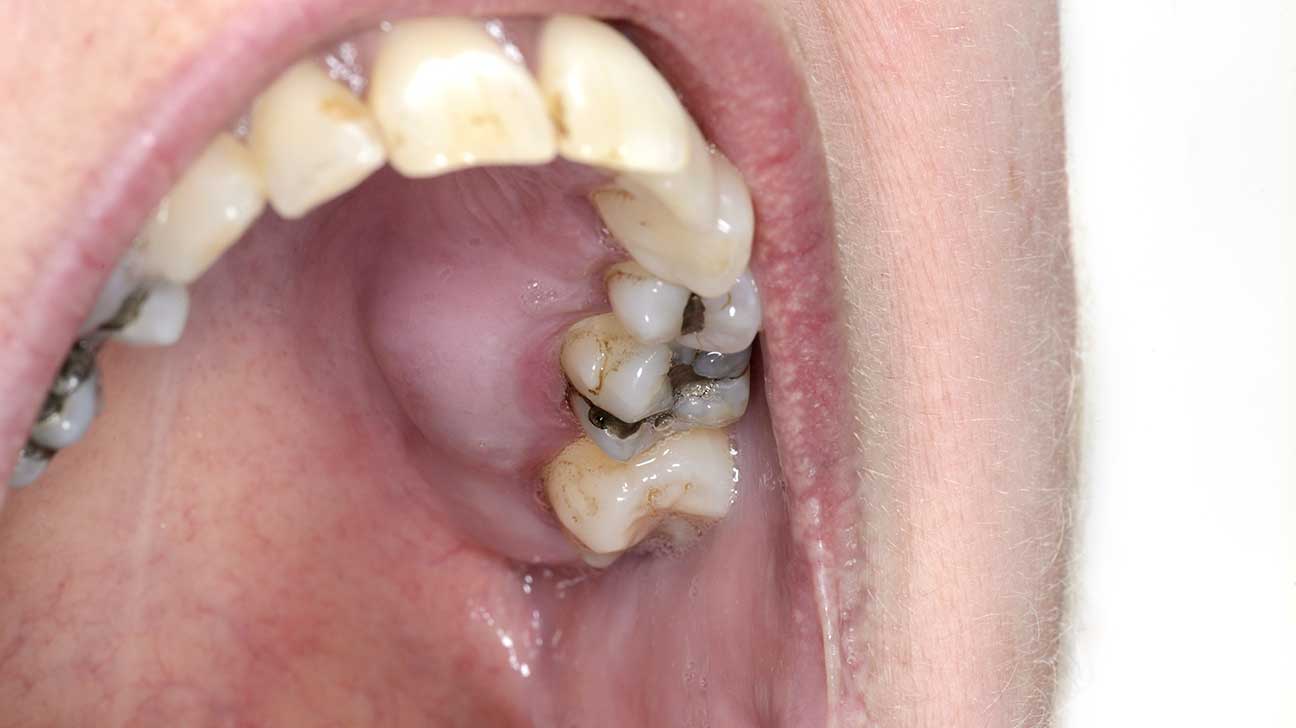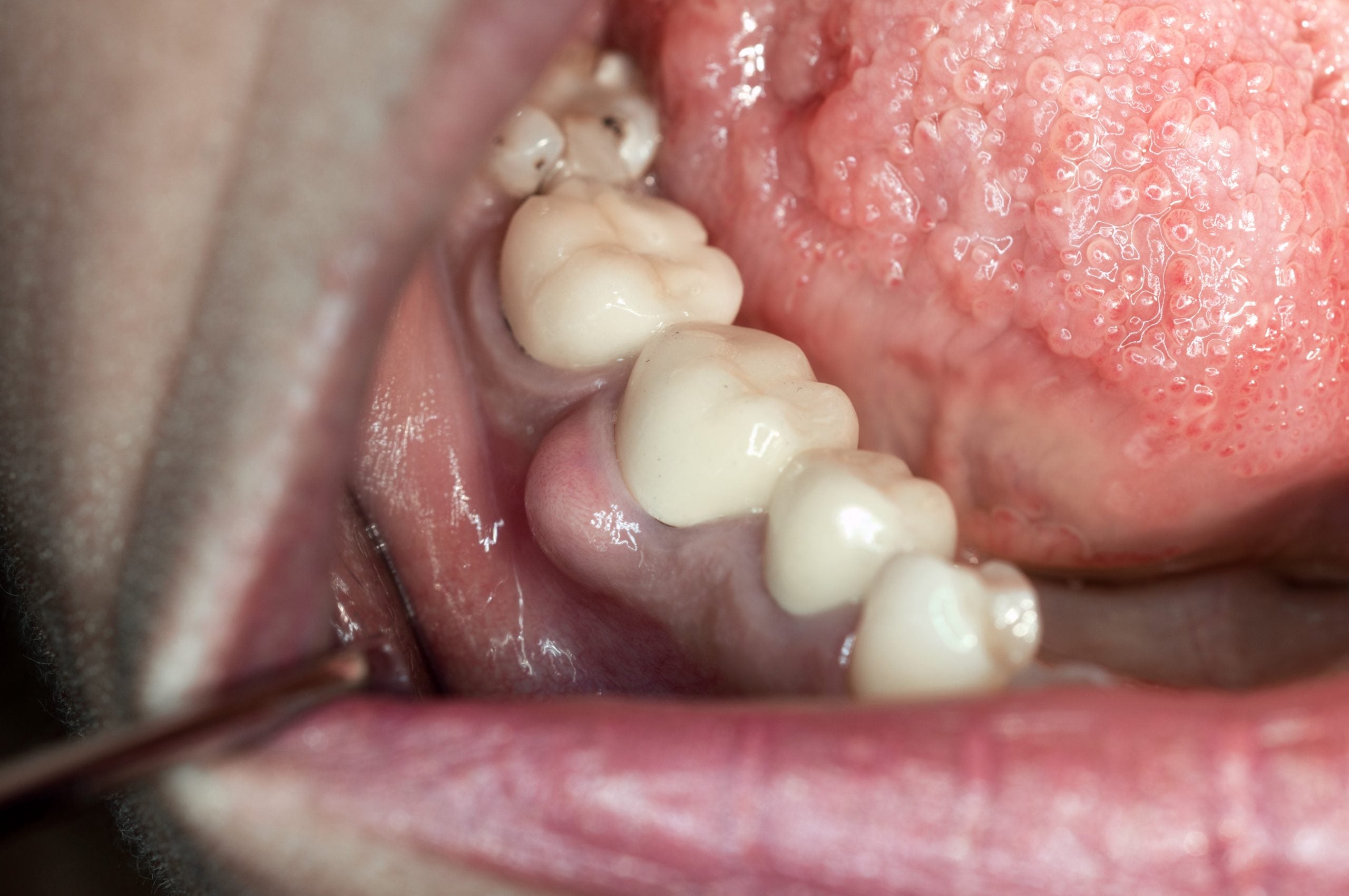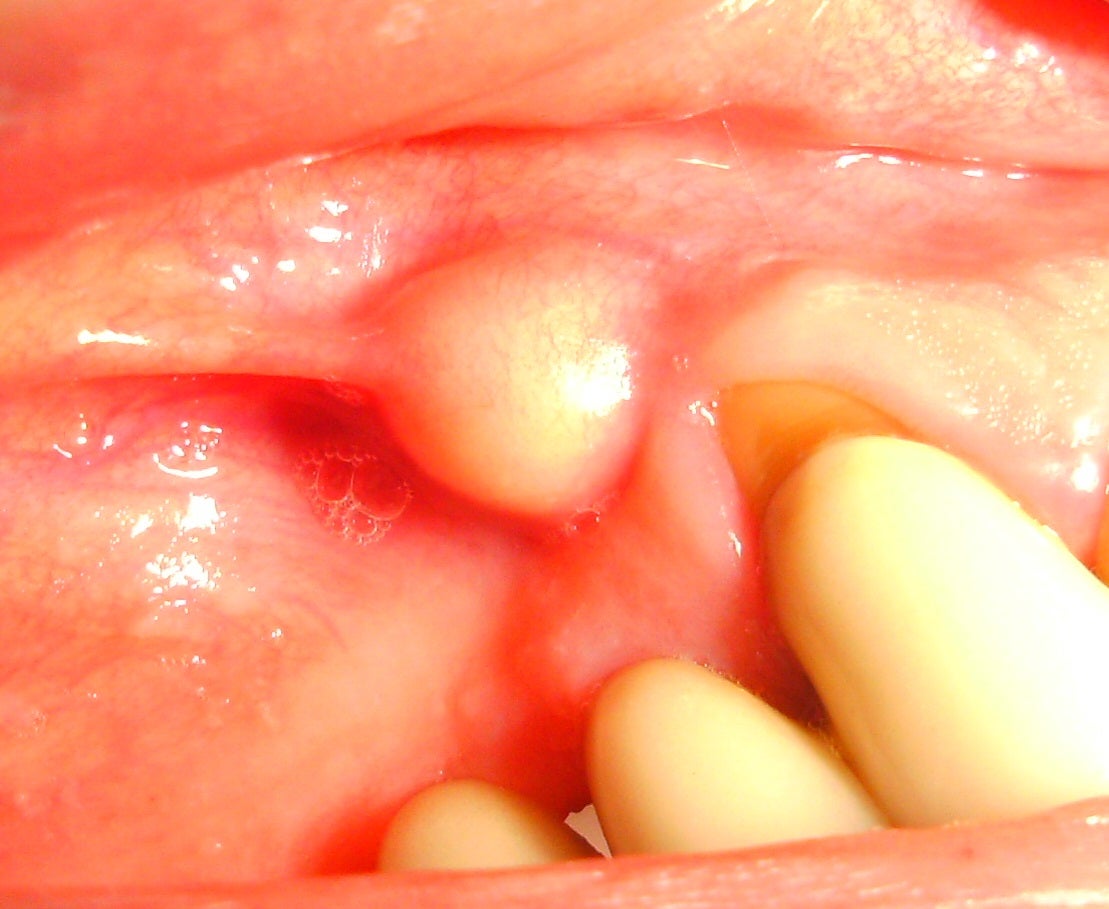Ouchies in the mouthies? Hold the phone — it could be a tooth abscess. And you need to do something about it pronto.
How to spot an abscessed tooth
Plenty of aches and pains can develop in your mouth. But an abscess has some telltale signs:
- swelling or redness in your mouth or jaw
- constant, intense throbbing pain that sticks around even after you take pain relievers
- pain that radiates to your ear, jaw, and neck in the area of the abscessed tooth
- pain that gets worse when lying down and interferes with your sleep
- teeth that feel tender and loose or look off-color
- a high body temperature and general feelings of illness (your body’s reaction to infection)
- a nasty taste in your mouth (due to pus draining from the abscess — yeah, you’re welcome)
- bad breath
- sensitivity to hot or cold food and bevvies
- problems swallowing or breathing if pain is severe
You’re going to need to see a dentist ASAP. They may prescribe antibiotics or perform a root canal.
What is an abscessed tooth?
An abscess happens when pus builds up in your teeth, your gums, or the bones that connect the two. If that sounds highly unpleasant, it’s because it is highly unpleasant.
Without treatment, abscesses get worse. They don’t always hurt, but they still pose a risk of infection.
We know you hate going to the dentist, but if you think you have an abscess, you need climb into that dentist’s chair and say “aaaaah” (or “aaaaaaaargh!” — whichever suits your mood best at the time).

Pick your poison: Types of dental abscess
The type of abscess you develop depends on where the bacteria build up.
- Periapical abscess. Pus builds up at the tip of the tooth root.
- Gingival abscess. A pocket of pus forms in the gum tissue around the base of your teeth.
- Periodontal abscess. This is a gum abscess that occurs in the gum at the side of your tooth’s root.
What do they look like?
You may see a small pimple, a boil, or even a large red lump on the side of your gum. An abscess inside your tooth is even worse — it’s a cavity gone bad.
If you’re not sure what’s behind the excruciating pain in your mouth, you might want to take a look. It’s not as easy as it sounds.
You’ll need a mirror. A small dental-type mirror on a long handle will be especially helpful. You could try taking a photo with your phone, but it’s dark in there. And besides, this is definitely not one for your Twitter feed.
If you see a pimple or boil on your gum, that’s where an abscess in the root of your tooth may be draining. In other words, bingo! You’ve done a heckin’ discover.
Gum abscesses take the form of a dark red swelling on the gum (it’s their Patronus, if you will). They may also cause throbbing pain that won’t quit. If you notice these and other symptoms, it’s time to go hang with your dentist for a bit.
Yummy, pictures!
You wanted to know what they look like, right? Scroll through the slideshow to see the different types of dental abscess.
Symptoms
So how do you know if the large lump on your gum needs you to bite the bullet (gently) and see a dentist?
- You experience swelling or redness in your mouth or jaw.
- You have constant throbbing pain despite taking pain relievers.
- You have a fever.
- The pain gets worse when you’re lying down.
- Your teeth or gums become extra-sensitive to hot or cold food and drinks.
- You feel increased pressure in the area as pus builds up.
- There’s a really nasty taste in your mouth
- Your breath is suddenly very smelly.
- You have difficulty breathing or swallowing. (This is especially serious — hit up your dentist right heckin’ now.)
Complications
Act fast! This is only going to get worse.
Abscesses don’t resolve without treatment. The infection can spread to your jaw and surrounding areas in your face, neck, and head. If the infection gets into your bloodstream, it could lead to more serious health issues like:
- respiratory disease
- rheumatoid arthritis
- high blood sugar levels due to periodontitis
An untreated abscess can lead to gingivitis or other gum disease, which can become chronic and very tough to treat.
In the early stages of gingivitis, the bacteria in the plaque keep building up and can make your gums bleed. Periodontitis can result in the loss of your tooth or, worse, the loss of some bone.
The risk of losing teeth sucks, but even more serious complications are possible. Without treatment, the bacteria from an infected tooth can make their way into your blood.
Your body’s defenses against infection are good, but they can’t fight it off forever. An unchecked dental infection can spread into other areas of your mouth, the glands in your neck, or even your whole face.
In the absolute worst-case scenario, it can become sepsis — a body-wide infection that overwhelms your immune system and can be fatal.
Why me? Causes
How did this all start? And why right before your big Zoom presentation at work?
Plaque’s the problem. If you don’t get rid of it, it builds up and sets off issues that could lead to unpleasant oral conditions like gingivitis and periodontitis. Eventually, plaque will hit its ultimate target — an abscess! (#SquadGoals, amiright? No, f*ck off, plaque.)
Here’s how the different types of abscesses develop.
Periapical abscess
This abscess of the root develops from an untreated dental cavity or a crack in a tooth. (Not to be confused with a Macavity, which is just who Idris Elba played in the movie “Cats.”)
The infection starts in the cavity or crack and travels through the tooth’s soft tissue (dental pulp in the innermost part of the tooth). It ends up in the very tip of the root, where it can’t go any farther.
(And if an abscess inside your tooth wasn’t enough, you’ve now got the song “Mr. Mistoffelees” stuck in your head.)
Gingival abscess
This type of abscess often happens when debris, such as food residue, gets lodged between the gum and the tooth. It can develop due to plaque and poor oral hygiene.
Periodontal abscess
This happens when gingivitis takes over, like adults should have done on the set of “Cats.”
Periodontitis creates pockets between your teeth and gums. These pockets fill with bacteria and — voila! Abscessimo.
Risk factors
These factors increase the risk of getting an abscessed tooth:
- A high sugar diet. Saliva helps protect your teeth from harmful bacteria in your mouth. But eating lots of sugary foods eventually erodes tooth enamel and weakens your teeth, causing cavities. Untreated cavities lead to abscesses.
- Dry mouth. This condition affects your saliva glands and can be caused by poor oral hygiene, certain medications, and aging. Saliva helps flush away the food stuck in your teeth — without it, your teeth would be in real trouble. If you have dry mouth syndrome, you need to drink a lot of water to flush out your mouth. Have a chat with your doctor or dentist about the problem.
- High blood sugar. This can translate to high glucose levels in your mouth, particularly if you have diabetes. High glucose levels increase bacteria and plaque growth, which often leads to gum disease.
You can reduce your risk by remembering what your mom always told you about cleaning your teeth and cutting down the sugar in your diet.
The tooth, the whole tooth, and nothing but the tooth: Treatments
Having an abscessed tooth = zero fun. But it’s treatable, which is more than can be said for the fact you still have “Mr Mistoffelees” in your head.
Don’t put it off. Cancel your plans and visit a dentist. We know you don’t wanna. But you have to catch an abscess before the infection has a chance to spread to surrounding tissue.
Failing that, your doctor is your friend. You’ll likely need pain relievers and maybe an antibiotic. A doctor can prescribe something a little stronger than what’s available over the counter.
Some home remedies can also help relieve pain, kill bacteria, and slightly bring down inflammation. But they are, unfortunately, no replacement for having a (medically qualified) stranger stick a (teeny-tiny) drill in your mouth.
Your dentist will take an X-ray to figure out which type of abscess you have and how badly it’s infected.
In the case of a periapical abscess, they’ll need to clean out the tooth (by doing a root canal) or extract it, depending on how f*cked it is.
Root canal treatment involves drilling into the tooth to drain the abscess. After draining and cleaning it, the dentist will fill your tooth to prevent further infection.
If you have a gum abscess, your dentist will lance it and clean it out. They will then apply an antiseptic or antibiotic to the abscess site to stop any further infection. They’ll also prescribe antibiotics.
If you keep getting periodontal abscesses, you can ask for a referral to a periodontist. They’ll be able to permanently remove the periodontal pockets that have formed in your mouth.
10 potential home remedies
These will be only temporary fixes but may help reduce pain while you’re waiting for your dental appointment. Abscesses are persistent little buggers. If an abscess is not thoroughly cleaned out, it’ll come back to make your life miserable, like the ex who won’t stay out of your inbox.
Essential information on oils
While research suggests there are health benefits, the FDA doesn’t monitor or regulate the purity or quality of essential oils. Talk with a medical professional before you begin using essential oils and be sure to research the quality of a brand’s products. Always do a patch test before trying a new essential oil.
When using an essential oil, always dilute it with a carrier oil like olive, coconut, or sesame oil.
You shouldn’t apply undiluted essential oils directly to your skin, and you definitely shouldn’t swallow them.
Give some of these natural remedies a try to see what works for you. Remember that they should not take the place of the medication your dentist has prescribed. Research doesn’t really back most of these options, but anecdotal evidence has suggested that they may help.
So take these with a pinch of salt (or a rub of crushed garlic, if you think it’ll help).
Take care when using any of these remedies for the first time, as some of the substances are potential allergens. Try a smaller dose than recommended, or test it by dabbing it on a small area of your skin and waiting 10 minutes to see how your skin reacts.
1. Saltwater rinse
Some test-tube research suggests salt may help beat back bacteria in your gums and promote wound healing factors. It’s cheap and easy, too.
- Mix 1 teaspoon table salt with 1 cup warm water.
- Swish it around in your mouth for more than 2 minutes, and then spit it out.
- Repeat this 3 times a day.
2. Baking soda rinse
Sodium bicarbonate (baking soda to its pals) can block bacterial growth and increase your salivary pH. It can be great for shifting plaque.
- Mix 1/2 teaspoon baking soda with 1/2 cup warm water.
- Swoosh it around your mouth for up to 5 minutes, and then spit it out.
- Repeat until you’ve finished the mixture.
- You can repeat this process twice a day.
3. Oregano essential oil
Oregano contains a compound called carvacrol that, according to a 2018 study, can help fight a wide range of bacteria and fungi. It might help reduce pain and swelling too. (This is an essential oil, so definitely dilute it in a carrier oil first.)
- Mix a few drops of oregano oil into 1 ounce of a carrier oil.
- Add a few drops of your mixture to a cotton ball and apply it to the infected area for 2 to 3 minutes.
- Wait 10 minutes before rinsing your mouth.
4. Cold compress
Same as when you boop your knee, this should help reduce pain and swelling.
- Wrap some ice cubes in a small towel.
- Hold it against your mouth for a few minutes.
- Repeat as often as you like.
5. Fenugreek tea
Folks throughout history have used fenugreek as an herbal remedy for dental pain. Does it actually work? There aren’t really studies confirming it. But if you’re at your wits’ end, give it a go.
- Heat 1 cup water and add 1 teaspoon ground fenugreek.
- Stir well and let cool.
- Apply to the affected area using a cotton ball.
- Do this up to 3 times per day.
6. Clove essential oil
This remedy has been used for centuries to cure toothache. In a 2020 study, cloves (Syzygium aromaticum L.) showed microbe-bustin’, inflammation-reducin’, and pain-squishin’ properties.
The jury’s still out on whether it will help you during times of extreme tooth pain, but if you find that it helps, it won’t hurt to keep trying. (Again, this is an essential oil. Be sure to dilute it in a carrier oil.)
- Mix a few drops of clove oil into 1 ounce of a carrier oil.
- Apply to the affected area using a cotton ball.
- Alternatively, use it as a mouthwash by diluting 3 or 4 drops in a glass of water and swishing it around your mouth for longer than 2 minutes.
- Apply up to 3 times a day.
7. Hydrogen peroxide
Hydrogen peroxide is sometimes used as a teeth whitener, but research has found that it can also help reduce gum inflammation. So it may take some pain off your plate while you wait for the dentist.
- Combine equal parts 3 percent hydrogen peroxide and water and swish the mixture around your mouth.
- Do not swallow it!
- Repeat multiple times a day.
8. Oil pulling
This is an ancient remedy used to treat mouth ailments. According to a 2017 review, oil pulling may remove toxins and freshen breath. The research on this is limited, but if it doesn’t hurt and has a chance of providing some relief, it’s worth a try.
- Swish one spoonful of olive, coconut, or sesame oil around your mouth vigorously for up to 20 minutes.
- Do not swallow the oil. Spit it out into the trash can. (Spitting it into the sink may clog the pipes — and you don’t need a plumbing bill on top of dental costs.)
It doesn’t sound very pleasant, but neither is an abscessed tooth.
9. Garlic
Garlic may provide pain relief, and one of its compounds, allicin, has strong antimicrobial properties. Garlic and antibacterial swagger go back thousands of years together. Plus, it keeps vampires out of your mouth.
- Crush a fresh clove of garlic into a paste (TBH, this would be cathartic as heck when your mouth hurts).
- Apply the paste to the infected area.
- Repeat this a few times a day.
10. Aloe vera
Aloe vera generally has antibacterial, anti-inflammatory, and wound-healing properties — you’re probably familiar with it from rubbing it into dry, sunburned skin.
Anecdotal evidence suggests aloe vera provides relief for swelling, bleeding gums and is an antiseptic for periodontal pockets.
Pour a little aloe vera gel or liquid onto a cotton ball and apply it to the affected area. (But be sure to use a product that’s specified for oral use.)
Some aloe vera products are edible, so you can leave them in your mouth for as long as you like — but never use aloe vera skin care products in your mouth.
Prevention
This is worth repeating: It’s all about keeping your mouth and teeth clean. Your dark, murky cakehole is full of bacteria, which create that sticky layer on your teeth that we call plaque.
You can absolutely prevent a dental abscess by maintaining these habits:
- Brush your teeth at least twice a day. (With toothpaste, obviously.) Going to bed at night with food in your teeth causes the food to rot overnight and creates acid on your teeth. Mama is always right.
- Remember to floss your teeth every day. Or at least get a floss in three or four times a week.
- Use mouthwash a couple of times a week. You can try the homemade herbal mouthwashes above or go straight for a store-bought mouthwash.
- Use an electric toothbrush if you have one. Electric toothbrush goes brrrrrrrrrrrrrrrrrrrr.
Make friends with your dentist and get a dental checkup every 6 months. This will help identify potential problems and reduce your risk of developing an abscess.
Outlook
If you get treatment before the infection spreads from the tooth, you can prevent serious complications.
You may have to undergo a painful procedure or even have the tooth removed, but there are proven ways to treat an abscessed tooth and manage the infection.
Just make sure you get it checked out as soon as you notice symptoms.
Takeaway
Don’t take an abscess in your mouth lightly. Ignoring it could lead to pain, tooth loss, and the risk of severe health issues like sepsis.
Get to your dentist’s office right away. The best way to motivate yourself to face your dentist is to give yourself a choice between getting a root canal and watching “Cats.” You’ll pick the root canal every single time.
The best way to avoid this nasty situation is to brush your teeth twice a day and floss regularly.




0 Commentaires